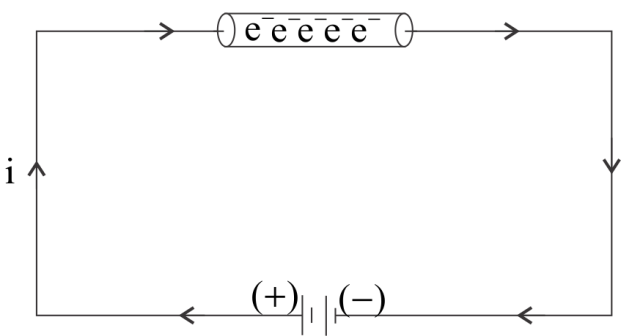
Current in a circuit flows:
(A) In direction from high potential to low potential
(B) In direction from low potential to high potential
(C) In direction of flows of electrons
(D) In any direction.
Answer
141k+ views
Hint:
Electrons always flow in opposite directions.
OR
The direction of an electric current is by convention the direction in which a positive charge would move.
Complete Step by Step Answer
Electric current flows from higher electric potential to lower electric potential.

If we put metal in an electrical circuit. As we know that current flows from positive terminal to negative terminal.
Then a positive terminal flows in the current direction. If electrons are present in metal then they flow opposite to applied current which means current flows in the direction of electric field.
Positive terminal is considered as high potential and negative charge is considered as low potential. The direction of motion of positive charge is always high potential to low potential but direction of motion of negative charge is always from low potential to high potential.
Which could be represented as
$V = - \phi \vec E.dr$
So we can say that current flows the same as direction of field and high potential to low potential.
Therefore we conclude that direction of current is always opposite to the direction of current that is high potential to low potential.
Hence the correct option is A.
Note:
For the current to flow, it required a circuit which is a closed loop of a conducting material. The circuit consists of wires which are connected end to end and the electrons flow in the same direction.
Electrons always flow in opposite directions.
OR
The direction of an electric current is by convention the direction in which a positive charge would move.
Complete Step by Step Answer
Electric current flows from higher electric potential to lower electric potential.

If we put metal in an electrical circuit. As we know that current flows from positive terminal to negative terminal.
Then a positive terminal flows in the current direction. If electrons are present in metal then they flow opposite to applied current which means current flows in the direction of electric field.
Positive terminal is considered as high potential and negative charge is considered as low potential. The direction of motion of positive charge is always high potential to low potential but direction of motion of negative charge is always from low potential to high potential.
Which could be represented as
$V = - \phi \vec E.dr$
So we can say that current flows the same as direction of field and high potential to low potential.
Therefore we conclude that direction of current is always opposite to the direction of current that is high potential to low potential.
Hence the correct option is A.
Note:
For the current to flow, it required a circuit which is a closed loop of a conducting material. The circuit consists of wires which are connected end to end and the electrons flow in the same direction.
Recently Updated Pages
Young's Double Slit Experiment Step by Step Derivation

Difference Between Circuit Switching and Packet Switching

Difference Between Mass and Weight

JEE Main Participating Colleges 2024 - A Complete List of Top Colleges

JEE Main Maths Paper Pattern 2025 – Marking, Sections & Tips

Sign up for JEE Main 2025 Live Classes - Vedantu

Trending doubts
JEE Main 2025 Session 2: Application Form (Out), Exam Dates (Released), Eligibility, & More

JEE Main Exam Marking Scheme: Detailed Breakdown of Marks and Negative Marking

JEE Main 2025: Derivation of Equation of Trajectory in Physics

Electric Field Due to Uniformly Charged Ring for JEE Main 2025 - Formula and Derivation

Learn About Angle Of Deviation In Prism: JEE Main Physics 2025

Electric field due to uniformly charged sphere class 12 physics JEE_Main

Other Pages
JEE Advanced Marks vs Ranks 2025: Understanding Category-wise Qualifying Marks and Previous Year Cut-offs

JEE Advanced Weightage 2025 Chapter-Wise for Physics, Maths and Chemistry

Degree of Dissociation and Its Formula With Solved Example for JEE

JEE Main 2025: Conversion of Galvanometer Into Ammeter And Voltmeter in Physics

Dual Nature of Radiation and Matter Class 12 Notes: CBSE Physics Chapter 11

Formula for number of images formed by two plane mirrors class 12 physics JEE_Main




